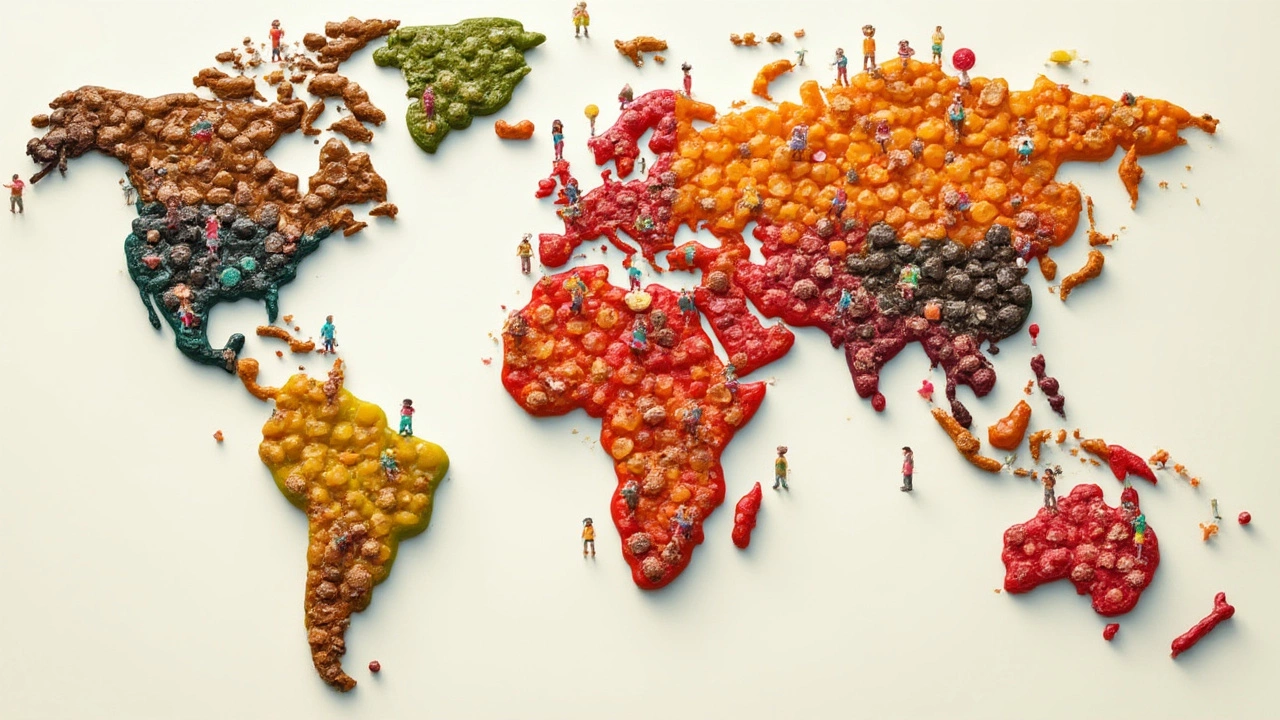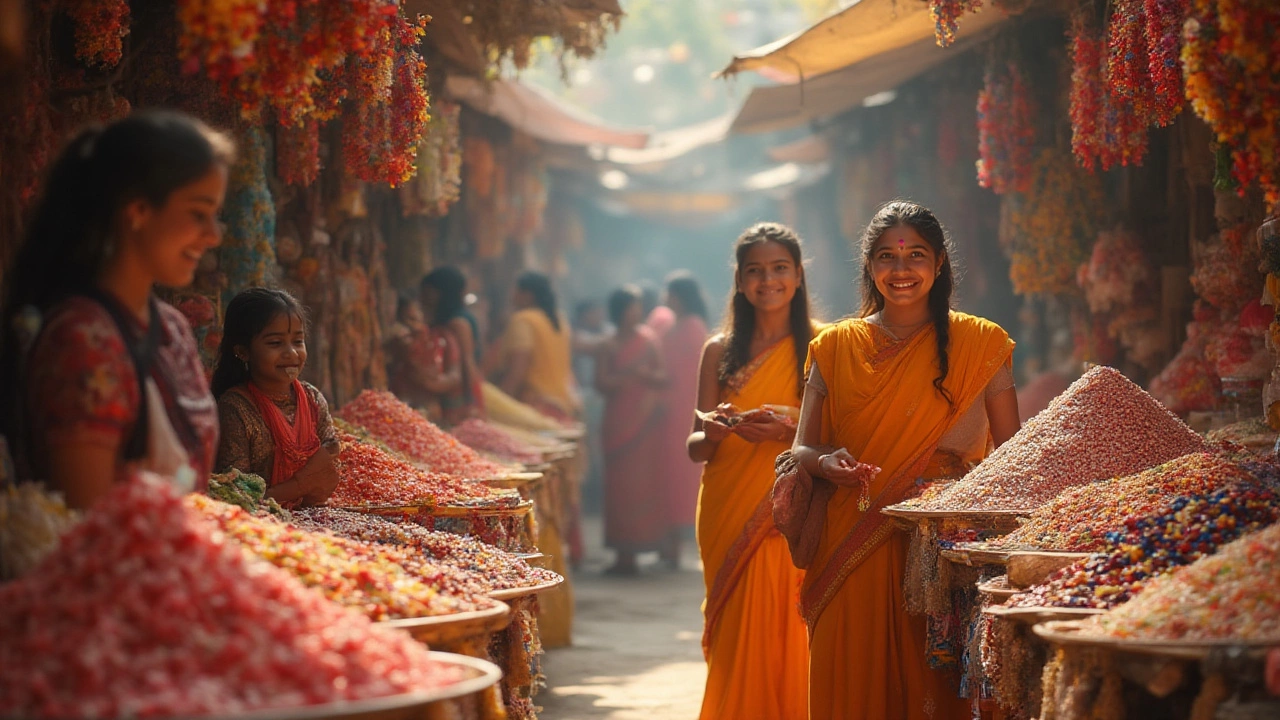Picture a mountain of colorful candies, chocolate rivers, trays of pastries, and endless rows of ice cream freezers. Ever wonder who actually eats the most of it? We’re not talking about the local kid with sticky fingers—we’re zooming out and asking: what nationality actually eats the most sweets, and why? Sugar might feel universal, but the real story is full of surprises. Welcome to a world tour of treats, overflowing with quirky habits, wild stats, and even a good old-fashioned rivalry between countries. Turns out, having a sweet tooth is a bit of a competition.
The World’s Sweetest Eats: Who Tops the List?
It’s easy to assume everyone loves sweets equally, but the numbers paint a different—and much sweeter—picture. When it comes to national sugar intake, you might guess it’s America leading the pack with supersized desserts and bottomless sodas. However, according to reliable data like the 2023 Statista Global Sugar Consumption Report and the International Sugar Organization, Germany actually wins the crown for sweets consumption. On average, each German polishes off around 28.7kg of sugar per year. Now, that doesn’t mean Germans just eat spoonfuls of sugar—it’s wrapped up in everything from pastries to chocolate bars. In fact, Germany is world-famous for confectionery brands like Haribo and Ritter Sport, and practically every city has a bakery within arm’s reach.
To make things clearer, here’s a peek at recent annual sugar consumption per capita from a selection of candy-loving nations:
| Country | Average Sugar Consumption (kg/person/year) |
|---|---|
| Germany | 28.7 |
| United States | 22.3 |
| Switzerland | 24.1 |
| Netherlands | 21.8 |
| United Kingdom | 21.2 |
| India | 19.5 |
These numbers might seem huge—and they are—but you won’t always see people walking around with bags of lollies in hand. In Germany, sweets show up at coffee breaks (Kaffee und Kuchen), workplace celebrations, and after-dinner treats. Meanwhile, Americans lean into sodas, fast food desserts, and ultra-sweet snacks, while Swiss residents have a special love for chocolate. Even India clocks in with a surprising amount thanks to an obsession with sweets like jalebi, gulab jamun, and mithai, fitting for a country that loves celebrating everything with sugar.
Traditional Treats Versus Candy: What Counts As “Sweets”?
A lot of debates spin around what actually counts as sweets. In some places, a “sweet” might mean chewy licorice or peppermint candy, while somewhere else it’s sticky baklava or a gooey chocolate cake. For the purposes of global sugar rankings, sweets usually include any food that loads up on added sugar—think candies, chocolate, cakes, cookies, pastries, and even sweetened drinks like sodas.
However, culture matters more than most people think. Take India, for example. A wedding or even a work milestone isn’t quite real until someone’s handed you a platter of mithai or scooped you a bowl of kheer, a rice pudding loaded with condensed milk and sugar. In Japan, wagashi like mochi or dorayaki are less about sugar highs and more about savoring subtle sweetness, with an emphasis on natural flavor. These sweets are art as much as food. In Canada and the U.S., candy reigns supreme—gummy bears, marshmallows, and chocolate bars line every supermarket aisle, often right next to the checkout for easy, last-minute grabs.
- German sweets: Gummy bears, marzipan, and legendary Black Forest cake.
- American favorites: Brownies, cupcakes, doughnuts, buckets of ice cream, and soft drinks.
- French flair: Flaky pastries, macarons, éclairs—or anything from a Parisian pâtisserie.
- Middle Eastern luxuries: Turkish delight, baklava loaded with honey and pistachios.
- Indian delicacies: Laddus, rasgulla, barfi—many using milk and natural sweeteners as a base.
This variety means that “sweet tooth” looks totally different in each country, even as everyone battles for that sugar superfan title. If you ever travel, stop by a bakery: you’ll see the patterns with your own eyes. In Sweden, the weekly fika (coffee and cake break) has become a part of national identity, while in Australia, lamingtons and pavlova are the ultimate sweet fixes during celebrations.

Sweet Tooth Habits: When, Why, and How People Eat Sweets
It’s not just how much, but also when and why. You’ll notice some countries build their entire daily routine around dessert. Italy’s classic “dolce far niente”—the sweetness of doing nothing—shows up at the end of relaxed dinners with tiramisu or panna cotta. In America, sweets end up as snacks—lunchboxes stuffed with fruit snacks, offices with jars of jelly beans, movie nights built around popcorn with extra caramel.
Life-stage traditions matter too. In Germany, it starts young—kids get their Schultüte, a cone of candies and school supplies, when they start first grade. In Japan, children celebrate Hinamatsuri (Girls’ Day) with pastel-hued sugar candies. And in Mexico, sweets pop up in piñatas at every birthday party, with everyone scrambling for their share once the goodies rain down.
What pulls people towards sweets? Often, it’s about celebration, ritual, or even rebellion. French children dip croissants in cocoa before school. Australians end BBQs with a mess of Tim Tams and fairy bread. And yes, sometimes it’s comfort—from heartbreaks to stress, a scoop of your favorite dessert is the universal cure.
Some countries even engineer their cities with sweets in mind. Take Belgian or Swiss train stations—nearly all have a chocolate shop. German Christmas markets? Wall-to-wall with candied nuts and gingerbread hearts. In Israel, teens famously munch on Bamba—peanut-flavored treats—practically by the fistful. The takeaway? Wherever you go, sweets are stapled into social rituals and daily habits, more than just “food.”
Why Some Countries Can’t Stop Eating Sweets
Several factors turn a country into a sugar super-consumer. It’s not just want, but access, culture, and even weather. Germans, for instance, have a historic connection to confectionery worth billions and a competitive market that pushes prices down, so everyone grabs those Haribo bears or Milka bars on impulse. Convenience stores and vending machines across Japan serve up everything from candy-coated nuts to Pocky sticks at all hours, feeding quick cravings during commutes.
| Country | Popular Sweets Industry Brands | Total Sweets Market Value (in USD billions) |
|---|---|---|
| Germany | Haribo, Ritter Sport | 28.8 |
| USA | Mars, Hershey, Jelly Belly | 43.6 |
| Switzerland | Lindt, Toblerone, Nestle | 9.3 |
| India | Haldiram's, Amul | 9.1 |
>From marketing blitzes that put chocolate bunnies front-and-center for Easter, to cultural practices like Diwali (when sweet trays are mandatory in India), sugar becomes irresistible. Weather even plays a role—cold climates in Germany, Switzerland, and the UK nudged these countries toward dense, high-calorie sweets that double as comfort foods during long winters. Meanwhile, in the tropics, fresh fruits and milk-based desserts occupy the sweet space but with slightly less sugar per serving, balancing the hot weather with cool, lighter treats like kulfi or fruit salads.
Don’t forget about government policies and health campaigns, though. In places like Norway and Sweden, high sugar taxes and public information drives have slowed down sweets consumption a bit, but they still celebrate pastry-heavy holidays with gusto. In Australia, campaigns to cut sugar intake are everywhere, but that hasn’t stopped the sale of lollies soaring at Halloween and Easter. People just swap one sweet for another.
If you want to fit into a new place, just understand the sugar protocol. In France, teens sneak macarons between classes. Brazilians finish lunch with brigadeiros, small fudge balls. You’ll realize that sweets consumption is about way more than taste—it’s about feeling at home, celebrating, and connecting.

Fun Facts, Surprising Stats, and Tips for Navigating the Global Sweet Life
Here’s where things get even sweeter—some facts blow all assumptions out of the water. Did you know the world’s most expensive dessert, the $25,000 Frrrozen Haute Chocolate, is served in New York? Or that Switzerland, despite small size, churns out 200,000 tonnes of chocolate annually—enough for each Swiss to nibble away 12kg yearly!
In Japan, KitKats come in over 300 flavors (yes, wasabi is one), and in India, there are regions where sweets are so central that towns are named after signature treats—like Rosogolla in Bengal. Germans have even created entire festivals around candy, like Cologne's Karneval, where locals throw thousands of lollies from parade floats. Australia isn’t far behind, either: ever tried a lolly called “Frogs in a Pond” at a kid’s birthday party?
If you’re traveling, want to try local sweets without going overboard, or just beat sugar fatigue at home, here are some handy tips:
- Look for shared sweets traditions: Try a coffee-and-cake moment in Germany, a mid-afternoon tea in the UK, or chai and ladoo in India. Experience the ritual as much as the flavor.
- Try sample boxes in new countries—many candy stores offer mini versions, great for tasting without overdoing.
- Mix sweets with moderation: Pair sugary desserts with nuts or fruit, turning indulgences into energizing snacks, or limit portions by splitting treats with a friend.
- Explore healthier versions: More places now offer low-sugar desserts—think dark chocolate, fruit-based ices, or sweets made with sugar alternatives like stevia or honey.
- If you’re watching your sugar, travel-savvy locals often enjoy sweet flavors through spiced teas, small fruit servings, or yogurt with honey instead of candy bars.
So, which nationality eats the most sweets? Right now, Germany sits at the top, but the truth is, every country finds its own way to bond and celebrate with sugary goodness. Whether you love a slab of Sachertorte, a chewy rasgulla, or just a handful of chewy candies, you’re tapping into a tradition as rich as it is universal. You can find a reason to enjoy a sweet treat anywhere—just look for the nearest festival, birthday, or morning coffee break, and you’ll be in good company.
